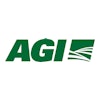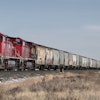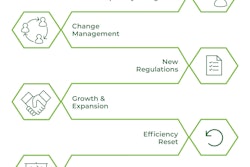
Safety — most of us like to think we lead pretty safe lives, and safety is not something we normally think about every day. Safety is an important topic, however, and as the new year starts, we thought we would get you thinking about some approaches to safety in your feed and grain business.
There are a number of things you can do as the “business” to make sure your workplace is safe. And then there are things that your employees can do to make sure that they are safe in their work. It’s important to pay attention to both areas.
Feed and grain safety
The feed and grain industry faces some specific dangers and hazards that require specialized training and approaches. Following are some of those challenges. In addition, the OSHA website is a good resource of safety related issues and ways to address them atosha.gov.
Confined space protection
Grain elevators and feed mills generally have a number of confined spaces. OSHA defines these as “while not necessarily designed for people, they are large enough for workers to enter and perform certain jobs. A confined space also has limited or restricted means for entry or exit and is not designed for continuous occupancy.”
在密闭空间经常发生,因为死亡atmosphere is oxygen-deficient, toxic or combustible, OSHA explains. Because of this, confined spaces should be classified as permit-required and tested prior to entry and continually monitored.
Confined spaces in your business should be identified, marked with warning signs and cautions related to them should be included in your safety training.
Grain bin safety
Grain and feed bins are one of the more unique safety hazards our industry faces. Employees should not enter bins while grain is being loaded or unloaded.
Suffocation is one of the most common causes of death involving grain bins, which can occur when someone enters a bin with flowing grain and is pulled under and covered with grain. A person can also actually suffocate when only chest deep in grain due to the force on the chest. Many people underestimate the massive force behind flowing grain. Standing on moving grain can be deadly — the grain works like quicksand to create suction that can bury a person in seconds.
Employees should wait until the dust clears so they can clearly see their footing before entering. However, even if a person can see, there may still be danger – you often can’t tell if a grain bridge exists by just looking. Employees should be aware of this and carry a pole with them into the bin to “poke” ahead of them to look for grain bridges.
The University of Illinois is a commonly cited source of tips for grain bin safety, and offer up the following suggestions for employees:
- Break up crusted grain from the outside of the bin with a long pole making sure it doesn’t come into contact with electric lines.
- Wear a harness attached to a properly secured rope.
- Stay near the outer wall of the bin, keep walking if the grain should start to flow and get to the bin ladder or safety rope as quickly as possible.
- If entering a bin is necessary, have another person (preferably two people), outside the bin who can help if an employee becomes entrapped. These people should be trained in rescue procedures and should know and follow safety procedures for entering the confined space.
- Grain fines and dust may cause difficulty in breathing — wear an appropriate filter respirator (see below).
- Stay out of grain bins, wagons and grain trucks when unloading equipment is running.
- 如果有必要进入本,关闭power to augers and fans. Lock out any unloading equipment before entering a bin to prevent someone from unintentionally starting the equipment while they are in the bin.
- Where possible, ladders should be installed inside grain bins for an emergency exit. Ladders are easier to locate inside a dusty bin if there are brightly painted stripes just above or behind the ladder.
Rescue tubes
A relatively recent innovation is the grain bin rescue tube. A rescue tube is designed to act as a barrier to remove the pressure of the grain from being exerted on the trapped person.
Once the tube is assembled around the person, the grain is removed from inside the tube, allowing them to be gradually unburied. The steps on the inside of the tube allow first responders to provide first aid and other rescue activities – without standing on the person who is trapped. Nationwide Insurance in partnership with the National Education Center for Agricultural Safety (NECAS -necasag.org) has recently sponsored “Grain Bin Safety Week,” and they are doing so again for 2019 – seenationwide.com/grain-bin-safety-week.jsp.
Dust suppression/air quality
As most industry professionals know – grain and feed dust is doubly challenging. Not only is it an irritant for employees breathing it during grain receiving or loading, but it can also be dangerously explosive.
Dust collection/suppression equipment can improve both problems significantly and is a worthwhile investment.
Ken Hellevang, an extension ag engineer at North Dakota State University states, “breathing in grain dust is often an overlooked hazard. Tiny particulates can settle deep inside the lung when you breathe them in, and make you ill.” Hellevang recommends a mask that’s rated either N-95 or N-99. Employees should be required to wear them when grain dust is present.
Safe employees
Outside of things you can do as an employer, it’s the responsibility of your employees to make sure that they themselves are also safe. This safety comes from performing their job correctly, following company policy, and not taking undue risks.
One of the ways to help insure compliance and working smarter is to provide training and education – so that your workers will know about possible risks and how to avoid them.
A good place to start is the National Grain and Feed Association’s website “Focus on Safety, found atngfa.org/issues/focusonsafety.
This site provides safety tips, some links to recorded webinars and seminars on safety topics, and has several safety training videos you can order.
Another proactive approach to safety is to institute a safety management system, which helps to make health and safety an integral part of your feed and grain business’s core operations. By designing, developing and implementing an effective safety management system, you will have the methods for managing, reporting, assigning responsibilities, planning and resourcing needed to create a safer workplace.
Safety management systems have six elements: 1) a safety plan; 2) policies, procedures and processes; 3) training and orientation; 4) monitoring; 5) supervision; and 6) reporting. It’s not enough to just adopt a safety management system.
You must also actively implement that system in your workplace. To do this, you must ensure that:
- Employees are involved in safety management
- Workers comply with procedures and instructions
- Workers are appropriately trained
- Workers are subject to ongoing supervision
Safety plan
A safety plan is a strategic action plan that forms part of the business plan. It analyzes the current and prospective risk for a company and charts how the risks will be eliminated and controlled over a calendar period.
It should also include a budget, and you must decide whom in your firm is in charge of the plan (you as the manager or your designee).
This plan will ensure that there is a governance structure within your company that ensures every worker clearly understands their safety obligations (and how to comply) and is accountable to carry out those obligations.
Policies, procedures and processes
Policies, procedures and processes include all safety documentation within your company. This paperwork will describe all safety behavior, expectations, record-keeping, incident reporting, and incident notification documentation.
Training and orientation
Everyone who starts work in your feed and grain company should receive training on the safety rules of your company, how to comply, and how to report safety violations. Ongoing education should also be provided on a regular basis.
Monitoring
Your obligations to monitor your workplace depend on circumstances and need. Always consider the level of risk. The higher the risk, the more frequent and detailed the monitoring needs to be.
There may be other times when monitoring may be necessary. For example: to ensure that all risk has been covered by a new risk assessment that has been carried out due to a change in process, such as the installation of new equipment or workstations; or when an investigation takes place following an incident.
Supervision
The only way to ensure your workers are carrying out their safety obligations is to have adequate supervision. The level of supervision required in your workplace will increase if the level of safety control put in place to reduce a risk is low, i.e. the less effective the control measure used, the higher the level of supervision necessary.
Reporting
The governance structure of your company needs safety reporting at all levels. Your workers need to know what safety looks like – what’s going right and what’s going wrong. This can only occur when they receive safety feedback from you.
Life is full of risks. Identifying and minimizing those risks, working safely, and educating your employees will let you sleep better at night, and will protect your employees and your business. ■
Dr. John Foltz is Chair, Department of Animal Sciences, The Ohio State University, Columbus, OH, and Dean Emeritus, College of Agricultural and Life Sciences, University of Idaho, Moscow, ID.
Dr. Christine Wilson is Professor and Director of Undergraduate Programs, Department of Agricultural Economics, Kansas State University.





















